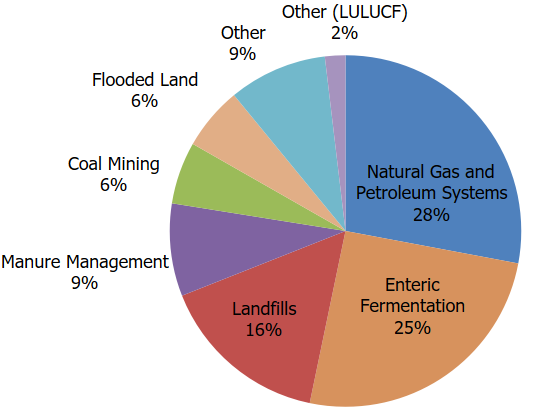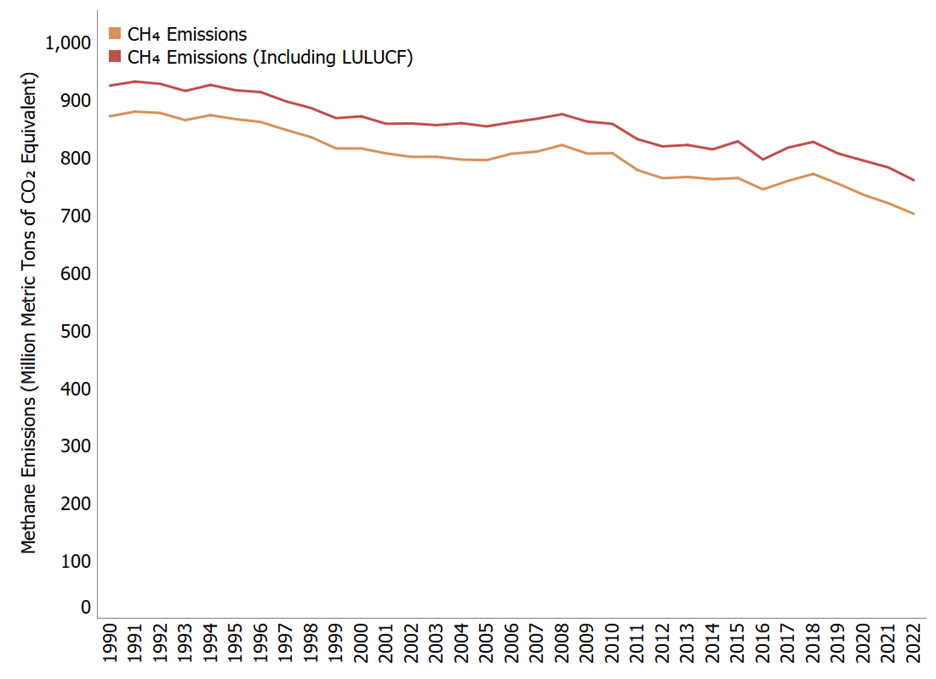Methane Emissions
Chemical Formula: CH4
Lifetime in Atmosphere: 12 years
Global Warming Potential (100-year): 281
On this page:
Sources of Methane Emissions
In 2022, methane (CH4) accounted for 12% of all U.S. greenhouse gas emissions from human activities (including LULUCF emissions). Human activities emitting methane include leaks from natural gas systems and the raising of livestock. Methane is also emitted by natural sources such as termites. In addition, natural processes in soil and chemical reactions in the atmosphere help remove CH4 from the atmosphere. Methane's lifetime in the atmosphere is much shorter than carbon dioxide (CO2), but CH4 is more efficient at trapping radiation than CO2. Pound for pound, the comparative impact of CH4 is 28 times greater than CO2 over a 100-year period.1
Globally, 50 to 65% of total CH4 emissions come from human activities.2 Methane is emitted from energy, industry, agriculture, land use, and waste management activities, described below.
- Agriculture. Domestic livestock such as cattle, swine, sheep, and goats produce CH4 as part of their normal digestive process. Also, when animal manure is stored or managed in lagoons or holding tanks, CH4 is produced. Because humans raise these animals for food and other products, the emissions are considered human-related. The Agriculture sector is the largest source of CH4 emissions in the United States. For more information, see the Inventory of U.S. Greenhouse Gas Emissions and Sinks Agriculture chapter.
- Land Use, Land-Use Change, and Forestry (LULUCF): Emissions of CH4 also occur as a result of land use and land management activities in the Land Use, Land-Use Change, and Forestry (LULUCF) sector (e.g. forest and grassland fires, management of flooded lands such as reservoirs, decomposition of organic matter in coastal wetlands).
- Energy and Industry. Natural gas and petroleum systems are the second largest source of CH4 emissions in the United States following the agricultural sources noted above. Methane is emitted to the atmosphere during the production, processing, storage, transmission, distribution, and use of natural gas, and the production, refinement, transportation, and storage of crude oil. Coal mining is also a source of CH4 emissions. For more information, see the Inventory of U.S. Greenhouse Gas Emissions and Sinks sections on Natural Gas Systems and Petroleum Systems.
- Waste from Homes and Businesses. Methane is generated in landfills as waste decomposes and in the treatment of wastewater. Landfills are the third-largest source of CH4 emissions in the United States. Methane is also generated from domestic and industrial wastewater treatment and from composting and anaerobic digestion. For more information, see the Inventory of U.S. Greenhouse Gas Emissions and Sinks Waste chapter.
Methane is also emitted from a number of natural sources. Natural wetlands that are not managed or changed by human activity are the largest source, emitting CH4 from bacteria that decompose organic materials in the absence of oxygen. Reservoirs and ponds with high organic matter and low oxygen levels also produce methane through the microbial breakdown of organic matter. Smaller sources include termites, oceans, sediments, volcanoes, and wildfires.
To find out more about the role of CH4 in warming the atmosphere and its sources, visit the Climate Change Indicators page.
Methane Emission Trends
Methane emissions in the United States decreased by 19% between 1990 and 2022. During this time period, emissions increased from sources associated with agricultural activities, while emissions decreased from other sources including landfills, coal mining and from natural gas and petroleum systems.
Reducing Methane Emissions
There are a number of ways to reduce CH4 emissions. Some examples are discussed below. EPA has a series of voluntary programs for reducing CH4 emissions, in addition to regulatory initiatives. EPA also supports the Global Methane Initiative, an international partnership encouraging global methane reduction strategies.
| Emissions Source | How Emissions Can be Reduced |
|---|---|
| Industry |
Upgrading the equipment used to produce, store, and transport oil and natural gas can reduce many of the leaks that contribute to CH4 emissions. Methane from coal mines can also be captured and used for energy. Learn more about the EPA's Natural Gas STAR Program and Coalbed Methane Outreach Program. |
| Agriculture |
Methane from manure management practices can be reduced and captured by altering manure management strategies. Additionally, modifications to animal feeding practices may reduce emissions from enteric fermentation. Learn more about improved manure management practices at EPA's AgSTAR Program. |
| Waste from Homes and Businesses |
Capturing landfill CH4 for destruction in a flare or conversion to renewable energy are both effective emission reduction strategies. Learn more about these opportunities and the EPA's Landfill Methane Outreach Program. Additionally, managing waste at a higher tier on the waste management hierarchy can reduce CH4 generation at landfills. Learn more about Sustainable Materials Management. |
References
1IPCC (2013). Climate Change 2013: The Physical Science Basis. Contribution of Working Group I to the Fifth Assessment Report of the Intergovernmental Panel on Climate Change. [Stocker, T.F., D. Qin, G.K. Plattner, M. Tignor, S.K. Allen, J. Boschung, A. Nauels, Y. Xia, V. Bex and P.M. Midgley (eds.)]. Cambridge University Press, Cambridge, United Kingdom and New York, NY, USA, 1535 pp.
2 IPCC (2021). Climate Change 2021: The Physical Science Basis. Contribution of Working Group I to the Sixth Assessment Report of the Intergovernmental Panel on Climate Change [Masson-Delmotte, V., P. Zhai, A. Pirani, S.L. Connors, C. Péan, S. Berger, N. Caud, Y. Chen, L. Goldfarb, M.I. Gomis, M. Huang, K. Leitzell, E. Lonnoy, J.B.R. Matthews, T.K. Maycock, T. Waterfield, O. Yelekçi, R. Yu, and B. Zhou (eds.)]. Cambridge University Press, Cambridge, United Kingdom and New York, NY, USA, 2391 pp.


